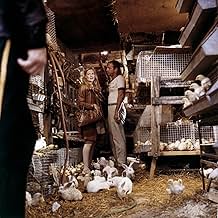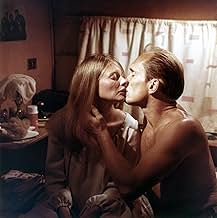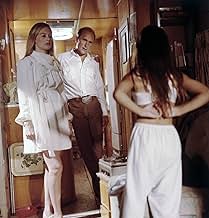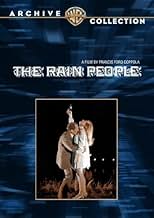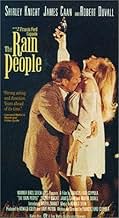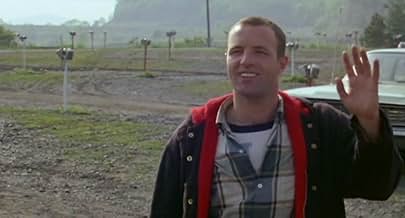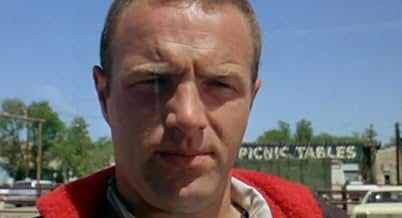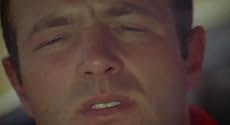PUNTUACIÓN EN IMDb
6,8/10
4,4 mil
TU PUNTUACIÓN
Una mujer embarazada se da a la fuga para obtener un poco de libertad y reevaluar sus elecciones vitales.Una mujer embarazada se da a la fuga para obtener un poco de libertad y reevaluar sus elecciones vitales.Una mujer embarazada se da a la fuga para obtener un poco de libertad y reevaluar sus elecciones vitales.
- Dirección
- Guión
- Reparto principal
- Premios
- 1 premio en total
Laura Crews
- Ellen
- (as Laurie Crews)
Garrett Cassell
- Farmer
- (sin acreditar)
Eleanor Coppola
- Gordon's Wife
- (sin acreditar)
Reseñas destacadas
Of all his films it would appear that Francis Ford Coppola is particularly fond of "The Rain People", a very modest and some might say 'arty' drama he made early in his career. Like a lot of American films popular at the time it's a 'road movie' with Shirley Knight as the young wife who ups and leaves her husband in the middle of the night, gets in her car and drives West for no paricular reason she can think of, meeting on her journey James Caan, (brain-damaged football player), and Robert Duvall, (randy motorcycle cop). She also happens to be pregnant and, like so many Americans in movies at the time, has gone off to 'find herself'.
Coppola says it was a personal project and there are some people who think it's his first masterpiece but it wasn't a hit and despite Coppola's name on the credits has become something of a lost movie. Knight is excellent as she mopes about and, you might say, teasing any man who comes her way while Duvall and especially Caan match her at every turn. You could say it's a quintessential American film of its time, a 'movie-brat' movie if there ever was one and Coppola's first real 'signature' picture, (though I do have a soft-spot for the wonderful "Finian's Rainbow" which preceeded it). If you do get a chance to track this down it is certainly well worth seeing.
Coppola says it was a personal project and there are some people who think it's his first masterpiece but it wasn't a hit and despite Coppola's name on the credits has become something of a lost movie. Knight is excellent as she mopes about and, you might say, teasing any man who comes her way while Duvall and especially Caan match her at every turn. You could say it's a quintessential American film of its time, a 'movie-brat' movie if there ever was one and Coppola's first real 'signature' picture, (though I do have a soft-spot for the wonderful "Finian's Rainbow" which preceeded it). If you do get a chance to track this down it is certainly well worth seeing.
Francis Ford Coppola's first 'personal' film, completed and released in 1969, was the last movie he made as a mostly unknown, up and coming director before The Godfather, and is in stark contrast to both that film, and the rest of his uneven career. It's ostensibly a road movie involving a disconnected young woman bored with domestic life, and pregnant with a child she isn't sure she wants, fleeing the trappings her dull marriage and hitting the open road in search of freedom. Along the way she befriends a nice man, an ex-footballer player that suffered brain damage from a traumatic head injury, played in unexpectedly subtle fashion by a young James Caan, and decides to 'help' him, despite becoming frustrated with his simple ways. Her efforts to rid of him always fail, either by guilt or chance, and eventually lead her directly into the hands of an emotionally wounded cop(Robert Duvall), who has ideas of his own. The plot is threadbare, but Coppola does a great job at detailing the emotional life of these characters, and uses editing techniques to relay back story that were not at all common in American films of the time. Shots are simple, yet extraordinarily effective, conveying both the moody desolation of the open highway, and the emptiness of American suburban life, infused with a gentle melancholy provided by the film score. Coppola also deserves credit for addressing the issue of domestic discontent from a woman's point of view in the culturally turbulent 60's. Overall, a fairly low-key film that is not what audiences have come to expect from Coppola, but one that is a minor triumph in its own quiet, unassuming way. 7.5/10.
This early Coppola work is overlong and erratic, but it is not devoid of praiseworthy qualities. The cinematography is excellent and the characters are memorable. James Caan is very convincing as the mentally handicapped hitchhiker. Also, because this film was shot on location all over the Eastern U.S., it offers an interesting, authentic look at America in the late 1960's. The title phrase does not have a significant meaning in the overall story, but only comes up during a conversation between the two lead characters (Caan and Shirley Knight). The way Coppola develops the characters by using short, dream-like flashbacks is very clever. In general, this film is not in the same class as Coppola's later work, but it's a solid character-driven story.
A 30-ish wife on Long Island (Shirley Knight) needs to just get away and so enters her station wagon and drives west. To where? She doesn't know, but she picks up an ex-college football player (James Caan) before meeting a motorcycle cop (Robert Duvall).
"The Rain People" (1969) was made three years before Francis Ford Coppola became famous with "The Godfather." It was his first movie in which he had total creative control, writing and directing on the road without producers breathing down his neck. The story was inspired by Francis' mother curiously leaving home for a few days when he was a kid. It's about a woman's haphazard search for freedom from the manacles of domestic life. Unlike the domineering male protagonists of "Patton" (which he wrote), the Corleone patriarchs and Kurtz in "Apocalypse Now," Coppola shows us here several females manipulating men: Natalie with Kilgannon, Gordon and even Vinny; Ellen with Kilgannon and her father; and Rosalie with her dad.
Interestingly, it's the express opposite of Francis' previous movie, the fun "Finian's Rainbow," which was based on the 1947 Broadway hit. One is an energetic musical with a large cast while this has an everyday, depressing tone, made with a small cast & crew. While neither were successful at the box office, they both went on to garner cult followings after Coppola's great success in the 1970s-90s (of course he had a few movies that didn't do so well, but what else is new?).
I can see where many viewers would find "The Rain People" dull, but it features a daring premise and has historical significance, not to mention some notable cast members. Plus, it's a quality period piece for the late '60s. In regards to the commendable premise, Natalie loves her husband, but is uncertain about the responsibility of having his child and so instinctively flees the scene. Ironically, Killgannon becomes her surrogate 'child' on her road odyssey wherein she struggles with her obligations.
Concerning the 'historical significance,' the industry proudly cites "Stand Up and Be Counted" as the first flick to address women's liberation, which it overtly does. But this came out three years prior and few people noticed at the time because it's so covert. It was ahead of its time.
Francis originally intended to include a scene at the end to clear up what Natalie decides to do from there, but it wasn't needed because everything is explained in her monologue. Listen.
It runs 1 hour, 41 minutes, and was shot over the course of five months in several American states with a 10-person crew (along with a smattering of locals). The locations include: Garden City (opening shot), Manhattan (Lincoln Tunnel) & Hofstra University, New York; the Pennsylvania Interstate; Harrisonburg, Virginia (restaurant scene); Clarksburg (the drive-in theater) & Weston, West Virginia; Chattanooga, Tennessee (the parade); Brule (the burning house) & Ogallala (the reptile ranch), Nebraska; and other places for exterior shots.
GRADE: B/B-
"The Rain People" (1969) was made three years before Francis Ford Coppola became famous with "The Godfather." It was his first movie in which he had total creative control, writing and directing on the road without producers breathing down his neck. The story was inspired by Francis' mother curiously leaving home for a few days when he was a kid. It's about a woman's haphazard search for freedom from the manacles of domestic life. Unlike the domineering male protagonists of "Patton" (which he wrote), the Corleone patriarchs and Kurtz in "Apocalypse Now," Coppola shows us here several females manipulating men: Natalie with Kilgannon, Gordon and even Vinny; Ellen with Kilgannon and her father; and Rosalie with her dad.
Interestingly, it's the express opposite of Francis' previous movie, the fun "Finian's Rainbow," which was based on the 1947 Broadway hit. One is an energetic musical with a large cast while this has an everyday, depressing tone, made with a small cast & crew. While neither were successful at the box office, they both went on to garner cult followings after Coppola's great success in the 1970s-90s (of course he had a few movies that didn't do so well, but what else is new?).
I can see where many viewers would find "The Rain People" dull, but it features a daring premise and has historical significance, not to mention some notable cast members. Plus, it's a quality period piece for the late '60s. In regards to the commendable premise, Natalie loves her husband, but is uncertain about the responsibility of having his child and so instinctively flees the scene. Ironically, Killgannon becomes her surrogate 'child' on her road odyssey wherein she struggles with her obligations.
Concerning the 'historical significance,' the industry proudly cites "Stand Up and Be Counted" as the first flick to address women's liberation, which it overtly does. But this came out three years prior and few people noticed at the time because it's so covert. It was ahead of its time.
Francis originally intended to include a scene at the end to clear up what Natalie decides to do from there, but it wasn't needed because everything is explained in her monologue. Listen.
It runs 1 hour, 41 minutes, and was shot over the course of five months in several American states with a 10-person crew (along with a smattering of locals). The locations include: Garden City (opening shot), Manhattan (Lincoln Tunnel) & Hofstra University, New York; the Pennsylvania Interstate; Harrisonburg, Virginia (restaurant scene); Clarksburg (the drive-in theater) & Weston, West Virginia; Chattanooga, Tennessee (the parade); Brule (the burning house) & Ogallala (the reptile ranch), Nebraska; and other places for exterior shots.
GRADE: B/B-
Early Coppola with sublime cast that most folks never got to see (a pity). There's some wonderful things going on in this one - Shirley Knight's best performance (an underrated actress), a road trip in the late 1960's, James Caan very restrained and moving, Robert Duvall in a part he was born to play (edgy, lonely, motorcycle cop), and a touching script with F. Coppola behind the wheel.
If this had been made five years LATER by some nobody, it would have been a smash (so much for timing). Anyway, I recommend this to all people who don't need outer-space explosions and bad mother-in-law jokes or a billion dollar budget to sit for a few hours and watch a story unfold. Give this one a chance if you can find it!
If this had been made five years LATER by some nobody, it would have been a smash (so much for timing). Anyway, I recommend this to all people who don't need outer-space explosions and bad mother-in-law jokes or a billion dollar budget to sit for a few hours and watch a story unfold. Give this one a chance if you can find it!
¿Sabías que...?
- CuriosidadesThe parade scene was filmed in Chattanooga, Tennessee on Memorial Day. The students in the band were not aware of what was happening. In fact, reading the lips of a majorette, she can be seen asking, "Who was that guy?" as James Caan was weaving through the parade.
- PifiasWhen Natalie first leaves her husband, she drives into a tunnel and emerges from on the west side of Manhattan. That is, she has driven east through the Lincoln Tunnel, presumably heading east. But immediately after, she stops at a phone booth to call her husband, saying she is in Pennsylvania, which is in the opposite direction. Had the intention to suggest a westward journey, she could have driven west through the tunnel to emerge in New Jersey.
- Citas
Natalie Ravenna: You are the most obedient man I've ever met in my life. Look at me. Aren't you?
Jimmy Kilgannon: Yes.
Natalie Ravenna: Aren't you?
Jimmy Kilgannon: Yes.
Natalie Ravenna: Aren't you?
Jimmy Kilgannon: Yes.
Natalie Ravenna: Aren't you?
Jimmy Kilgannon: Yes.
Natalie Ravenna: Alright.
- ConexionesEdited into Filmmaker (1968)
Selecciones populares
Inicia sesión para calificar y añadir a tu lista para recibir recomendaciones personalizadas
- How long is The Rain People?Con tecnología de Alexa
Detalles
- Fecha de lanzamiento
- País de origen
- Idioma
- Títulos en diferentes países
- Gent de pluja
- Localizaciones del rodaje
- Chattanooga, Tennessee, Estados Unidos(Veterans Day parade)
- Empresas productoras
- Ver más compañías en los créditos en IMDbPro
Taquilla
- Presupuesto
- 750.000 US$ (estimación)
Contribuir a esta página
Sugerir un cambio o añadir el contenido que falta

Principal laguna de datos
By what name was Llueve sobre mi corazón (1969) officially released in India in English?
Responde

